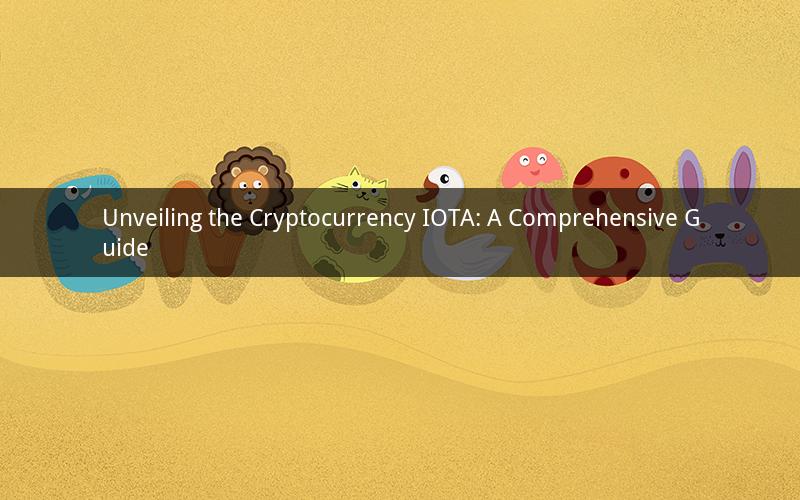
IOTA, often hailed as the Internet of Things (IoT) cryptocurrency, has been making waves in the blockchain industry. But what exactly is IOTA, and how does it differentiate itself from other cryptocurrencies? This article delves into the intricacies of IOTA, exploring its origins, technology, use cases, and future prospects.
Origins of IOTA
IOTA was founded in 2015 by David Sonstebo, Dominik Schiener, Sergey Ivancheglo, and David Lloyd. The team was driven by the vision of creating a decentralized platform that could enable seamless transactions between IoT devices. IOTA aimed to address the limitations of traditional blockchain technology, particularly the issue of scalability.
Technology Behind IOTA
IOTA employs a unique technology called Directed Acyclic Graph (DAG) instead of the traditional blockchain. Unlike blockchain, which relies on a linear chain of blocks, DAG allows for parallel transactions, making it more scalable and efficient. IOTA's DAG is known as Tangle, and it operates on the principle of proof of work.
In Tangle, every transaction is validated by the sender and receiver of that transaction, ensuring a decentralized network with no central authority. This mechanism makes IOTA a more energy-efficient alternative to blockchain, as it eliminates the need for mining.
Use Cases of IOTA
IOTA's innovative technology has paved the way for various use cases across different industries. Here are some notable examples:
1. IoT: IOTA's low transaction fees and scalability make it an ideal candidate for IoT applications. By enabling devices to transact directly with each other, IOTA can streamline data exchange and reduce costs.
2. Smart Cities: IOTA can play a crucial role in smart city development by facilitating the communication between various IoT devices, such as sensors, traffic lights, and streetlights. This can lead to improved energy efficiency, reduced traffic congestion, and enhanced public safety.
3. Supply Chain: IOTA can enhance the transparency and traceability of supply chains by enabling real-time tracking of goods and verifying their authenticity. This can help businesses reduce fraud, improve efficiency, and ensure compliance with regulations.
4. Renewable Energy: IOTA can enable peer-to-peer energy trading between renewable energy producers and consumers, promoting the adoption of clean energy sources and reducing the dependency on fossil fuels.
5. Healthcare: IOTA can improve the security and interoperability of healthcare data by providing a decentralized platform for data exchange. This can lead to better patient care, streamlined administrative processes, and reduced healthcare costs.
Future Prospects of IOTA
IOTA has a promising future, with several ongoing projects and partnerships. Here are some key developments:
1. IOTA Foundation: The IOTA Foundation is actively working on improving the Tangle protocol and expanding its ecosystem. They have recently launched a new initiative called IOTA 2.0, which aims to address the limitations of the current Tangle and introduce new features.
2. IOTA 1.5.5: The latest version of IOTA's software includes several improvements, such as enhanced security, better performance, and support for multiple programming languages.
3. Partnerships: IOTA has formed strategic partnerships with various industry leaders, such as the Volkswagen Group, Microsoft, and the United Nations. These collaborations aim to promote the adoption of IOTA in various sectors.
4. IOTA token (MIOTA): IOTA's native token, MIOTA, has seen significant growth in value over the past few years. As the demand for IOTA increases, the value of MIOTA is likely to rise further.
5. IOTA 2.0: The upcoming IOTA 2.0 update is expected to revolutionize the IOTA ecosystem. With its improved features and scalability, IOTA 2.0 has the potential to become a leading cryptocurrency in the IoT space.
Frequently Asked Questions (FAQs)
1. What is the difference between IOTA and blockchain?
The primary difference between IOTA and blockchain is the underlying technology. IOTA uses a Directed Acyclic Graph (DAG) called Tangle, while blockchain relies on a linear chain of blocks. Tangle allows for parallel transactions, making IOTA more scalable and energy-efficient.
2. Can IOTA be used for everyday transactions?
Yes, IOTA can be used for everyday transactions. However, due to its current limitations, it is not widely adopted for this purpose. As the technology matures and its ecosystem expands, IOTA could become a viable alternative to traditional payment methods.
3. Is IOTA secure?
IOTA's security is based on the Tangle protocol, which ensures that every transaction is validated by the sender and receiver. This decentralized approach reduces the risk of fraud and hacking. However, like any cryptocurrency, IOTA is not immune to security threats, and users should take appropriate precautions to protect their assets.
4. What is the future of IOTA?
The future of IOTA looks promising, with ongoing projects and partnerships aimed at expanding its ecosystem and improving its technology. As the demand for IOTA grows, its value is likely to increase, making it a valuable investment for long-term holders.
5. How can I purchase IOTA?
You can purchase IOTA using various cryptocurrency exchanges. Some popular exchanges include Binance, Bitfinex, and Kraken. Before purchasing IOTA, ensure that you understand the risks involved and have taken appropriate precautions to protect your investment.